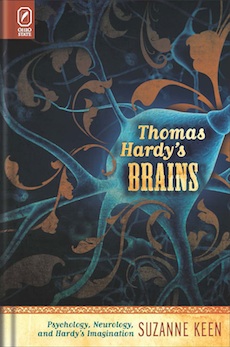Shortlisted for the 2015 Christian Gauss Award
By Sarah Gustafson
Suzanne Keen’s Thomas Hardy’s Brains is an impressive work of scholarship. It offers an analysis of Hardy’s oeuvre that doubles as a study of Hardy’s own brain, and the ways his thought translated philosophy and radical new Victorian-Edwardian science into literature. By highlighting his studies of psychology and Victorian brain science, and stressing its complementarity with the author’s attraction to Spinoza, Mill, Comte, Darwin, Fourier, Spencer, and Kant, among other philosophers, moralists, and scientists, Keen offers and justifies an essential intervention in Hardy studies.
Hardy is often portrayed as neurotic and unforgiving of humanity, an impression which the dark or tragic nature of his masterpieces only perpetuates. Not that it is an unsupportable position; she cites him in Life and Work: “You may regard a throng of people as containing a small minority who have sensitive souls…. So you divide them into the mentally unquickened, mechanical, soulless, and the living, throbbing, suffering vital… into souls and machines.” But he thought this of humanity having lived (1840-1928) through some of England’s most disruptive, transformative years.
What Keen demonstrates over the course of approximately 200 pages is that his act of categorizing humanity meant he saw each part of humanity in its individuality. It produced in him a desire to awaken readers to the human and to that deserving of our understanding in each situation. Hardy built a literature that “[takes] advantage of readers’ emotional dispositions to involve them in the experience of his fictional beings.” Thus Thomas Hardy’s Brains is just as much about his brain as it is about the powerful effects he produces on readers.
It is simply mind-boggling the changes in society, politics, industry, and science that Hardy observed in his lifetime. One criticism of this book is that it perhaps does not ground the reader enough in that context. However, this is not a work of social history, and, as suggested above via the list of Hardy’s philosophical touchstones, Keen shows how the realm of ideas shifted alongside the changing conditions of English life. Not content to examine Hardy’s studies of philosophy or science, she also delves into the psychology and neurology of the age and the author’s reception by notables like Havelock Ellis, and later Freud.
The realm of ideas informed Hardy’s thought and narration just as the physical landscape of Dorset/Wessex and the countryside did. That marriage of ideas and atmosphere is indebted to (or at least in the spirit of) Charles Darwin. Keen writes that Hardy “brought a Darwinian sense of the process of coadaptation to his description of the interactions of character and environment, while character itself he saw as shaped by both heredity and human instincts.” Later, she describes him as “a human geographer before that discipline existed.”
In other words, we can clearly see people’s life stories written on their bodies, their bodies being a product of time, environment, and personal evolution from lessons learned. However, we as individuals cannot perceive how that lived experience of others translates into character and motivation.
Will any given other be a machine or soul? To what extent do nerves make souls into machines, with automatic responses to external stimuli that have been hardwired by previous experience? And how does any person’s awareness of this—to the extent he or she is aware—inform his fate? As readers, guided by Hardy’s hand, we are privy to some of the answers. But, autonomous, fully individuated and dignified, Hardy’s creations remain others, “condemned to feel” and react unpredictably. No matter their status, they are fundamentally equal and equally vulnerable to accident by virtue of this common human characteristic.
In the five chapters, moving from the influences on Hardy himself, to his characters, to his poetry, to what Keen deems the “neurological turn,” to an exploration of his strategic narrative empathy, Keen displays complete control over her subject. In the first few pages of the book, Keen uses the above quotation on dividing mankind into machines and souls. So ending on the note of empathy, a word Hardy himself never used, may be a surprise. But it is a tribute to the research Keen has done to get inside Hardy’s own head that, in the final chapter, “Empathetic Hardy,” we are less surprised.
Seeing the universe as inimical to human kind and to humans’ kindness to one another, he wrote in such a way as to endow even the machines—peasants, members of outgroups, animals, etc.—with humanity. Through his sometimes humorous, sometimes tragic, but always respectfully precise character portraits, no one appeared less than a full individual. Stubborn, capricious, sensitive, selfless, guarded, impervious, pitiful, overly logical, or overly emotional, his characters seemed to possess a vitality that neither they nor their creator can control once set in motion.
Yes, Hardy “created” Wessex. But it is this quality of humanity with which he endows his creations that makes him a creator with a purpose: “His strategic empathizing… reveals a life-long project of attempting to revise human conduct, in a modest version of the Positivist religion of humanity, tempered by skepticism.” On the foundations of philosophy and science, and through his command over the written word, he creates a literary experience that makes us yearn for more kindness in a universe that can quash it.
It is as though Hardy intended that his literature, allowing us access to the lives of others, serve as nearly-lived evolutionary experience, experience that marks us and inspires us to be that force for kindness. Perhaps we could all benefit from a little more reading of Hardy.
Sarah Gustafson (ΦBK, Davidson College, 2014) is a candidate for the master’s degree in the History of Political Thought and Intellectual History at University College London, and looks forward to her future pursuit of a Ph.D. in European History.




